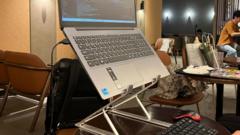In the bustling areas of South Korea, particularly Daechi in Seoul, cafes are facing a new challenge: "Cagongjok" culture. This term is used to describe the young people who set up their laptops and devices for long hours, thereby demanding more from cafe resources than just coffee. Hyun Sung-joo, who runs a cafe, recently recounted the bizarre sight of a customer using two laptops and a six-port power strip, effectively monopolizing an outlet for an entire day. As cafes struggle with high rent, keeping tables occupied by singular customers presents a dilemma.
Starbucks Korea has responded by implementing new national guidelines that discourage excessive setups, such as desktop monitors or partitioned workspaces. Even though they promise not to kick customers out, the latest rules aim to encourage a more social atmosphere by minimizing disruptions. Although most students like 18-year-old Suneung exam preparers haven't felt the changes yet, they still occupy tables for hours, leaving belongings unattended.
Mixed reactions have emerged from the public. Many patrons appreciate the guidelines, hoping to reclaim seat availability for casual visitors, while others feel the changes are an overreaction. Independent cafes are also trying to strike the right balance; some owners have adopted a "No Study Zone," limiting study times to prevent monopolization of their spaces.
Cafes are seen as sanctuaries to some, including Yu-jin Mo, who finds comfort in them over libraries due to a tumultuous past. As Professor Choi Ra-young notes, the Cagongjok trend reflects South Korea's hyper-competitive society, demanding more public spaces for relaxation and study. This ongoing conversation highlights the intricate dynamics of social spaces in contemporary South Korea, where the needs of the many clash with the few.

















